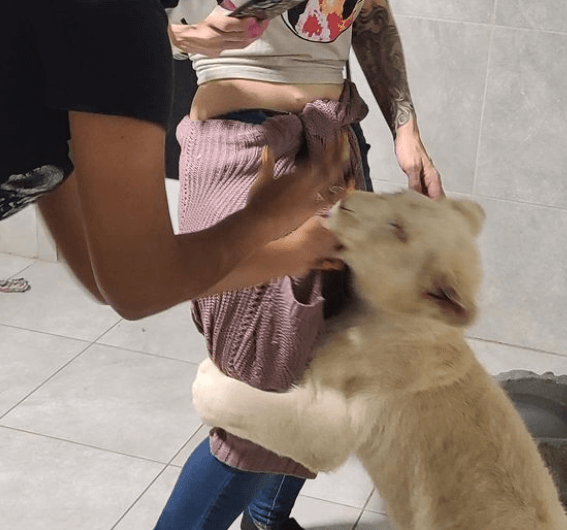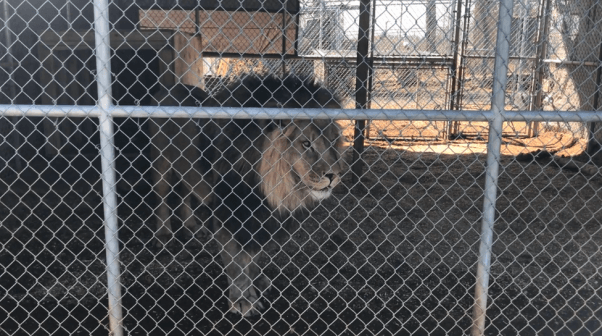These Folks Learned the Hard Way: Big Cats Are Dangerous Predators
The only way to force big cats to perform or endure photo ops and other unwanted contact with the public is under the threat of physical punishment, so it’s no surprise that some become so distressed by the unnatural conditions that they lash out. Hundreds of humans and other animals have sustained injuries and even been killed at roadside zoos—cruel tourist attractions that often pose as “sanctuaries,” “rescues,” “refuges,” or even “orphanages” for cubs—attempting to capitalize on big cats’ allure. Take a look at some of the most recent and shocking incidents, and learn how easy (and important) it is to tell a true big-cat sanctuary from a fake one.
March 2022
On March 22, a worker at Wooten’s Everglades Airboat Tours—a roadside zoo in Ochopee, Florida, that falsely touts itself as a “sanctuary”—had to be hospitalized after reaching into a tiger’s enclosure and sustaining injuries to his arms in an attack. According to NBC-2, the worker “followed [another staffer] to an outer enclosure where two tigers were being fed” and then “stuck his hands through the fence trying to pet one of the tigers.” The tiger apparently bit both of his arms—according to responding deputies, “his tendons were visible.”
The incident could easily have turned deadly, and as long as the public believes that it can ever be safe to pet a tiger or otherwise harass wild animals, it’s a matter of when, not if, something like this will happen again. “That’s why PETA is pushing for the Big Cat Public Safety Act to pass and urging the public to avoid any place that exploits big cats for big bucks,” said PETA Foundation Associate Director of Captive Animal Law Enforcement Debbie Metzler.
A true sanctuary would never allow visitors or anyone else to hoist up an alligator whose snout is banded shut for a photo op, force wild or exotic animals to partake in other dangerous stunts, or otherwise exploit animals.
Please, never visit Wooten’s Everglades Airboat Tours or any other roadside zoo—and click below to let your U.S. representative and senators know that you support the Big Cat Public Safety Act, which would end private ownership of dangerous big cats and ban cub-petting, safeguarding both wild animals and communities across the country:
August 2021
An inspection report released in August confirmed that after PETA alerted the U.S. Department of Agriculture (USDA) to Instagram posts (below) depicting dangerous public encounters with lion cubs at Mario Tabraue’s Zoological Wildlife Foundation (ZWF) of Tiger King infamy, the agency slapped the facility with numerous citations for failing to meet the minimum requirements of the federal Animal Welfare Act. According to the report, a lion cub bit a visitor (an example of a lion being a lion that shows why animals should never be used as photo props) and ZWF allowed public contact with a juvenile lion, which, it notes, would “pose a risk of injury to the public.” The USDA then went a step further and issued the roadside zoo an official warning over the incidents. This means that if these violations reoccur, ZWF could face civil penalties or other sanctions, including criminal prosecution.

This isn’t the first time a ZWF visitor has been bitten by an animal there. Late last year, the Florida Fish and Wildlife Conservation Commission (FWC) issued the roadside zoo a written warning after a child was bitten by a juvenile chimpanzee named Limbani. The FWC advised ZWF to stop allowing public contact with the 40 plus–pound chimpanzee immediately, but evidence from social media indicates that the facility allowed members of the public to have full contact with him since then, even as he grew larger and more dangerous.
The newly released report also cites ZWF for not having an enrichment program for primates. The USDA previously cited the roadside zoo in relation to its primate housing: It confined two incompatible macaques together, and one chased and bit the other, leaving her with bleeding wounds.

In a separate incident, on August 6, a cleaning and maintenance worker at Rancagua Safari Park—a drive-through roadside zoo in Chile—was mauled to death by a tiger while cleaning an enclosure. A local police officer reported that the worker “did not realize that the door of the animal’s cage was open and was immediately attacked by this tiger.” Patrons of the facility are reportedly driven around in jeep-like trucks, and big cats are able to climb on and around them—putting everyone involved in danger.
July 2021
On July 20, a tourist trap in Lebanon known as Animal City posted a video to Instagram showing patrons apparently mocking and laughing at a lion, who appears to be agitated by the interaction. The menagerie—which included the hashtags #wildsanctuary and #animalshelter in its post—was attempting to promote the “face-to-face encounter” but is instead facing serious backlash from furious viewers. One commenter called the encounter “disgusting” and “vile,” while another called it “hell for animals.” And they’re right—lions belong in the African savanna or the forests of Asia, where they can roam free with the rest of their pride, not in an enclosure where they can’t avoid contact with humans. Please, stay away from this ramshackle roadside zoo and any other establishment that promotes encounters that cause animals stress—including photo opportunities (for which Animal City appears to exploit lion and bear cubs, monkeys, snakes, and other animals) and “face-to-face” experiences.
To help big cats and other animals who are torn away from their mothers when they’re just days or weeks old and forced to participate in photo ops right here in the U.S., please take action:
May 2021
Authorities in China’s Henan province reportedly shot dead two tigers on May 25, 2021, after the big cats killed an employee of Danjiang Peacock Valley (the tourist trap where the tigers were imprisoned) and escaped from an enclosure. They had apparently been “on loan” from a circus in the nearby city of Suzhou in the province of Anhui. (Discover what a PETA Asia investigator observed while visiting 10 circuses and animal-training facilities in Suzhou.) The employee was reportedly mauled while trying to feed the tigers. According to a local forestry bureau statement, authorities killed them “[a]fter repeated attempts to ensnare the two tigers failed.”
The shootings followed a harrowingly similar incident that took place just days prior: On May 23, a 55-year-old employee of a tiger-breeding operation—also located in Anhui, the same province where the circus that loaned out the two now-dead tigers is located—was mauled by a tiger after entering the big cat’s enclosure. The employee, who was described in some reports as a “veteran” tiger breeder, apparently entered the animal’s enclosure to clean it without first making sure that the big cat’s shifting cage (the space that keepers shift a dangerous animal to so that they can safely enter the main cage) was locked. The employee sustained scratches and bites to the face, neck, and back and reportedly died after being taken to hospital.
None of these tigers or humans needed to die—these incidents are just more proof that exploiting tigers and other big cats is risky business as well as unethical. Warn your family, friends, and followers to stay away from shoddy operations like these …
… and keep scrolling to find out how you can do more to speak up for exploited big cats.
February 2021
At the Barry R. Kirshner Wildlife Foundation in Oroville, California, a 3-year-old leopard named Royal attacked a volunteer and then escaped from his primary enclosure. According to roadside zoo owner Roberta Kirshner and her staff, the volunteer had entered the cage containing the adult leopard—a predator strong enough to carry three times his own weight into a tree—and the animal jumped on her, causing five puncture wounds in her neck. He then escaped into the fenced-in area outside his enclosure before being captured, all while guests were present on the property.
“Any big-cat expert knows that sending a volunteer into a cage with a powerful predator is a recipe for disaster,” says PETA Foundation Associate Director of Captive Animal Law Enforcement Debbie Metzler. “The Barry R. Kirshner Wildlife Foundation either doesn’t know what it’s doing or doesn’t care, and PETA is calling on the U.S. Department of Agriculture to hold this sham sanctuary accountable for placing volunteers, visitors, and big cats at serious risk.”
In response to the incident, PETA submitted a formal complaint to the U.S. Department of Agriculture, calling on it to investigate the roadside zoo, whose previous federal Animal Welfare Act violations include allowing members of the public to have dangerous contact with lions, tigers, and a bear.

Please speak out to help make a difference for the animals trapped at the Barry R. Kirshner Wildlife Foundation.
January 2021
“I knew that he had me and that it was over.” That’s what 18-year-old Somer Stevens was thinking after a tiger named Eeyore clamped down on her arm with his jaws at the ironically named Tiger Haven in eastern Tennessee on January 25. The aftermath of the incident was caught on camera via bodycam footage:
While attempting to change out Eeyore’s water, Stevens (an employee of the roadside zoo at the time) reportedly slipped and fell toward the tiger’s enclosure—that’s when Eeyore pounced. “It almost felt like I could feel my muscles ripping in half and I swear if he would’ve pulled it one more time, my arm would’ve been off of my body,” Stevens said. Her fiancé, Gage Gilmore (who also seemingly worked at the fake rescue), shoved a piece of bamboo down Eeyore’s throat, causing the big cat to gag and release Stevens’ arm.
Does this sound like a “haven” to you?
Someone who is inexperienced with big cats shouldn’t have been cleaning tiger cages completely alone—but what’s more, neither Eeyore nor the roughly 265 other big cats who are apparently trapped at Tiger Haven should be there.
Don’t be fooled by places that use words like “sanctuary” or “rescue.” Discover how can you tell a true tiger sanctuary from a fake one, and tell your friends and family to stay away from roadside zoos.
August 2020
His scalp “hanging from his head” and his right ear “torn in half”—that’s what 50-year-old Dwight Turner came away with after paying $150 for a “full-contact experience” with a black leopard at a backyard zoo in Davie, Florida, on August 31. Michael Poggi, who reportedly claims to operate a “sanctuary” for rare and endangered animals, apparently runs the exploitative operation.
According to investigators, Turner’s $150 payment allowed him to “play with [the leopard], rub [the big cat’s] belly and take pictures.” As soon as he walked inside the leopard’s enclosure, the big cat attacked him. As a result, Turner reportedly spent a week in an emergency room—he had to undergo multiple surgeries and developed an infection that required additional treatment. The Florida Fish and Wildlife Conservation Commission cited Poggi for allowing full contact with an extremely dangerous animal and cited the sham sanctuary operator for maintaining captive wildlife in an unsafe manner.
December 2018
Humans and animals will keep losing their lives as long as unaccredited roadside zoos keep imprisoning dangerous animals for entertainment. Case in point: At a facility calling itself Conservators Center in Burlington, North Carolina, 22-year-old Alex Black—an unpaid intern—was reportedly killed by a lion named Matthai while cleaning an enclosure on December 30, 2018.
The big cat had managed to escape from the area to which he’d been confined and entered the same space as the intern before killing her. Sheriff’s deputies apparently shot and killed Matthai in order to retrieve the intern’s body.
October 2016
What’s in a name? For Spirit of the Hills Wildlife Sanctuary, a big fat lie. On October 1, 2016, a tiger reportedly named Boomer held at the Spearfish, South Dakota, roadside zoo escaped through an open gate and bit the facility’s founder several times. Local law-enforcement officers shot and killed the animal.
Following the attack, U.S. Department of Agriculture and Ohio Department of Agriculture officials transferred 18 animals—including 10 big cats, seven bears, and one wolf hybrid—from the fake sanctuary to the accredited Wild Animal Sanctuary in Keenesburg, Colorado, which is also home to many tigers and bears rescued by PETA.
Spotting a Fake Sanctuary or Rescue Is As Easy As 1, 2, 3
Big cats are intelligent, self-aware animals. Those held at profit-hungry tourist attractions—even ones that are deceptively called “sanctuaries” or “rescues”—endure heartbreaking physical and psychological abuse that’s inflicted in order to force them to tolerate direct contact with the public. It’s little wonder that so many reach their breaking point. But discerning which sanctuaries are shams and which are legitimate is easy—before visiting one, ask these three questions:
- Are big cats bred at the facility?
- Does the facility allow photo ops or other human interaction with big cats?
- Is the facility missing a Global Federation of Animal Sanctuaries accreditation?
If the answer to any of the above is “yes,” stay away. A true big-cat sanctuary would never buy, sell, trade, breed, exploit, or profit from them. Authentic sanctuaries don’t force these naturally fearful animals into unwanted contact with a barrage of strangers. Click to learn more about telling a true sanctuary from a scam …
… and to do more to help tigers suffering for photo ops:

